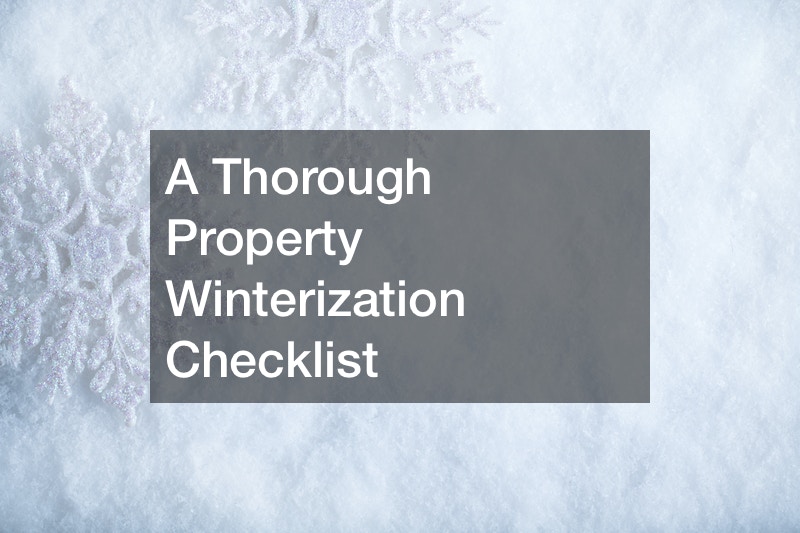
A Thorough Property Winterization Checklist

Do you live in a place where the weather gets rough and harsh during the winter season? Is your home not protected against extreme temperatures and storms? Well, winter is considered one of the harshest seasons of the year. With this in mind, it is important to understand the important elements of a property winterization checklist.
If you want to make sure that your family is safe and protected no matter what season comes along, then it would be best for you to prepare now by making some crucial changes inside your house, such as having an efficient heating system installed or transforming your entire house into a shelter.
It would surely be a great idea for you to learn more about what you can do to make your house safe and protected. What is the advantage of synthetic grass during winter? Instead of spending much on re-planting every year, you should consider investing in artificial grass that can last up to seven years or more depending on its quality and care.
Below are other things you will find in a property winterization checklist:
Remove Window Air Conditioners
This is perhaps one of the essential steps in the property winterization checklist to protect your home during the winter. Still, it is often overlooked by homeowners who are only concerned about keeping their house warm enough to prevent pipes from freezing or bursting. Most modern furnaces have built-in limit switches designed specifically to go off whenever they detect an unusually high temperature, like if you leave a space heater on while the heat itself is turned off, for example.
The danger of leaving your AC unit in place during the dead of winter is that it can cause your furnace to fail when power is restored after an outage. If this happens, you could be left with expensive repair bills and a frozen AC unit. For this reason, it is best to remove the window unit entirely while you are away and bring it back inside after you return. Remove AC units, putting them in a shed or garage that is not connected to your house’s heating system.
If you do not have an area outside of your home where you can store the AC unit during the winter, call a local business that offers storage options and inquire about their rates and availability (this option may be more expensive than simply putting the heater in a shed or garage). To avoid damage from freezing temperatures while you are away on vacation, keep window units indoors if possible; alternatively, bring units inside overnight while you sleep so they will not freeze.
If keeping your AC unit inside is not an option, put it in place with no snow accumulation to prevent parts from being weighed down by heavy snowfall. Also, place a tarp or other cover over the unit to prevent precipitation and ensure that it does not freeze to the ground.
Turn off at least one of your furnace’s limit switches if you have a room air conditioner with its thermostat. This ensures that your AC unit will not shut down while trying to keep your house cool during an outage, which could ultimately cause problems for your furnace when the power comes back on (and vice versa). Turning off these limit switches can be accomplished with a simple flip of a switch in your furnace’s electrical panel; consult the owner’s manual for instructions specific to your furnace model/manufacturer combination.
Drain Your Home of Water

Draining your home water is another crucial tip on a property winterization checklist. Of course, if you have a garden hose or any outdoor spigot left on during freezing weather, there is a good chance that the entire house could be flooded when power is restored, which would cause even more problems than just an overflowing toilet or two. To avoid this possibility, drain all pipes and appliances before letting them freeze up for however long you will be gone. This includes washing machines and dishwashers and cooking equipment like stoves and ovens, even PEX tubing under the floor.
You can always wait to drain water lines until you are ready to leave town but be sure they are drained of all water before freezing weather sets in. This is not a do-it-yourself project unless you have the necessary equipment and know-how, so contact a plumber or heating/cooling contractor if you need help draining pipes.
Another thing to look out for in the property winterization checklist is preventing septic system backups. Now is the time to make sure your septic tank and leach field are winterized, which will prevent flooding during the next big storm as residential water damage restoration services can be quite costly. This work may be performed by a plumber or an irrigation contractor, though it can also be done with materials available at hardware stores (e.g., seepage pit kits).
Toss Out Any Perishables in Your Fridge or Freezer

This should be an obvious first step in the property winterization checklist, but it can be tough to know where to start when pulling things out, especially if you are dealing with a very large freezer. If that’s the case, follow this rule of thumb: Anything that may go bad should be stored at 40°F or below (combination freezers/fridges included). And if it cannot stay cold enough for long enough, do not even bother taking it with you at all: toss it now, so someone else does not have to deal with it later!
If you have a generator, turn it on now to verify that everything will work when you need it. While some people store their generators in an outbuilding or basement during colder months, be careful where you keep your generator because gasoline requires proper ventilation. Also note: Never use a generator indoors or in attached garages since dangerous carbon monoxide fumes could enter the home.
In addition to storing water bottles in the freezer, try placing a small towel over any exposed half-liter bottles or other openings in your fridge/freezer (like an ice maker line) when leaving for long periods. If there is condensation on the floor of your freezer, remove standing water with paper towels, then dry up excess moisture with a fan pointed inside at low speed. Be sure to clean office buildup from coils every few weeks, too, and do not forget to dust off the fan motor! This will help reduce any humidity that can lead to condensation on walls/floors or corrosion on coils.
Check for Cracks In Your Home
If you do not live in a particularly cold area (e.g., northern states or mountainous terrain), having thermal insulation blankets may not be critical to the property winterization checklist. This is because heat loss is expected even during colder months so long as your heating system can keep up once the temperature drops below freezing. But if you live somewhere where the weather swings from warm to cold, it is important to check your windows and doors for any leaks where cold air can get in.
A basic test for air leaks is to close off all the interior doors of your home, turn on your heating system, and then check each window and door to see which ones are letting in cold air (and thus lowering the effectiveness of your heating system). If you find areas that need improvement, it is probably best to contact a contractor specializing in insulating windows and doors.
Also: Most newer homes come with weather-stripping already installed; if you live in an older home, though, make sure there are not any cracks where drafts could leak in. And when replacing exterior storm windows or sliding glass door panels, remember these two tips: Make sure they fit well (i.e., no significant gaps) and seal well (i.e., no light coming through, either) to prevent cold air from seeping in; and buy double-paned versions for maximum insulation benefit.
Configure Heating Equipment So It’s Ready for the Winter
It is important to take note of the important tips in the property winterization checklist. Before leaving your home for the season, ensure your heating system is configured to maximize its effectiveness once temperatures drop below freezing. If you have a radiator or baseboard heater, then it should be set on low now, and if you are planning on using space heaters during winter, they should be tested to ensure they are producing adequate heat before chilly weather sets in.
Also: When weatherizing windows and doors, pay attention to insulating fireplaces, wood stoves, and chimneys. For example, a sealed fireplace is a must-have to keep cold air from seeping in; likewise, the firebox should be kept clean and free of debris so that it can produce heat once temperatures drop below freezing (and do not forget about the flue venting system any buildup could prevent hot fumes from escaping into the sky). You will need to ensure your water heater is in its right state during the winter. Be keen on every aspect of heating your home may adopt for a comfortable winter season.
Clean Up After Yourself Before Leaving

If you go and stay elsewhere during the colder months, cleaning is a crucial part of the property winterization checklist. Ensure your decks are well kept. You should also unplug all appliances and electronics that won’t come with you since this will save them from sucking power when the grid is restored.
Turn off all breakers before leaving town to avoid opening up the electrical panel when an emergency arises. Also, make sure all portable heaters are unplugged and any emergency heat sources (wood stoves) are properly attended to. This is also an essential step to follow when installing temporary heating equipment for the winter (i.e., space heaters). Note: If you live in an older home with knob-and-tube wiring, always turn off the circuit breaker whenever working with your electrical system; more about this issue here.
Unplug appliances that are not being used for the winter or are replaced with non-electric alternatives. Appliances to unplug include anything that runs on electricity but is not regularly used: TVs, DVD players, stereo equipment, computers, printers, microwaves, hairdryers/flat irons, etc. Also, if you have a fireplace insert or woodstove, make sure it is fully vented to the outdoors during cold weather (if your chimney ices up during sub-freezing temperatures, this indicates that the venting system is not adequate).
Clean the house of debris to avoid clogs if water does come into contact with your piping system. This is a seemingly simple step but perhaps one of the most overlooked by forgetful homeowners. Even if no water does enter the home, cleaning up now will still prevent potential clogs later, and that is always better than dealing with a plumbing problem when you are on your way out! If your house gets hit by an unexpected deluge upon returning, it may save you hundreds of dollars in pipe damage if the work is done already.
Test All Alarms and Smoke/Co Detectors, Change Batteries if Needed
Testing your carbon monoxide detector is another crucial element in the property winterization checklist: this colorless, odorless gas causes many fires. You can check out our website for basic troubleshooting tips, but you should also consult the manual that came with your CO detector for step-by-step instructions. If it is time to replace the unit, now is a good time to think about upgrading to an interconnected model, so you have more peace of mind when the power goes out or temperatures drop below freezing.
Another part of the property winterization checklist is to ensure you recharge fire extinguishers. This is especially important if they have been sitting in a corner for way too long (or on top of a mantle, in the case of an extinguisher under a high shelf). If the gauge reads Replace, then you will need to get your hands on another one.
Weatherstripping doors and windows is especially important if you are storing gas appliances inside since there are some concerns that carbon monoxide could become trapped in the house when outside temperatures start dropping. Be sure to use weatherstripping for all exterior doorways, including garage entrances, where applicable but also ensure that this material does not obstruct electric or manual locks.
Remove Outdoor Furniture, Decorations, Trash Cans, and More

During winter storms with high winds, it is very easy for items like porch furniture or grills to end up in the wrong place (i.e., in your living room). If you are not using outdoor furniture and decorations this winter, store them indoors at home or in a storage unit.
Another crucial factor in the property winterization checklist is the clearing of gutters with the help of a local roofer and de-icing of walkways/paths. Before you start shoveling or buying salt, take note: Average consumer salt is generally okay for driveways and sidewalks (which only need an application of about one cup per five square feet), but it is much too harsh for use around vegetation because it could kill plants at such low concentrations. It is also not recommended to use rock salt when there is snow on the ground since it can become diluted by melting snow and ice. And while pushing or blowing snow off your roof or gutter is considered safe, please only let a professional in roof and gutter service remove snow from roofs, whether they are above ground level or not. With this in mind ensure you look out for reputed roofing services to get quality services in readiness for the winter season.
Homeowners have a responsibility to ensure their houses are well prepared for the winter. With a property winterization checklist, you can enhance the safety of your home and its occupants during different seasons. Ensure you undertake all the relevant services, including professional tree service, among other things that will promote preparedness to withstand the varying season year by year.





